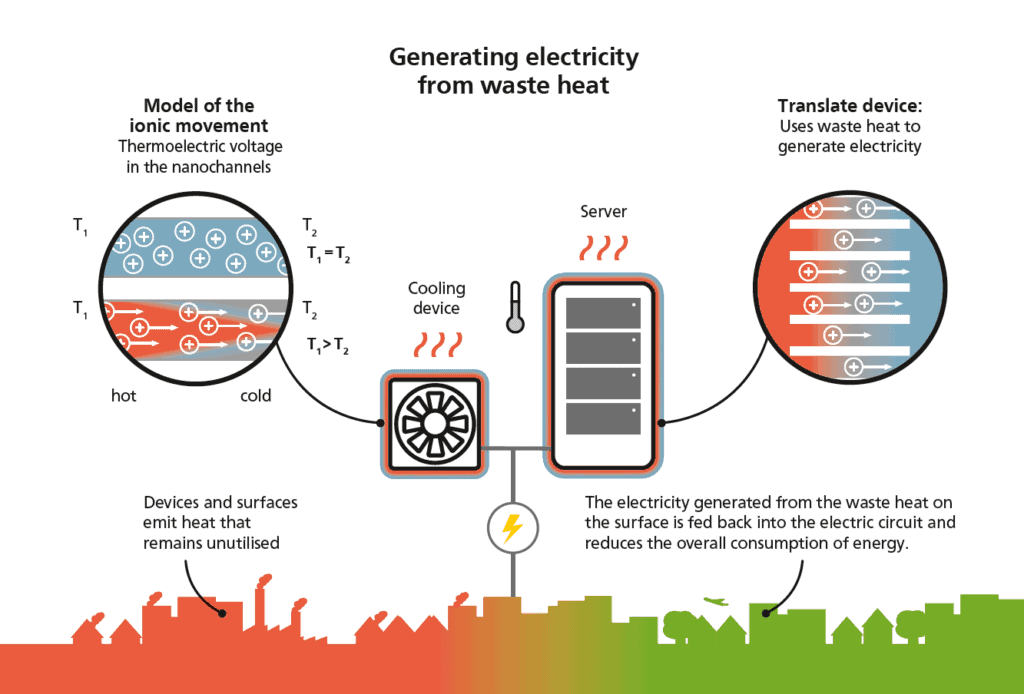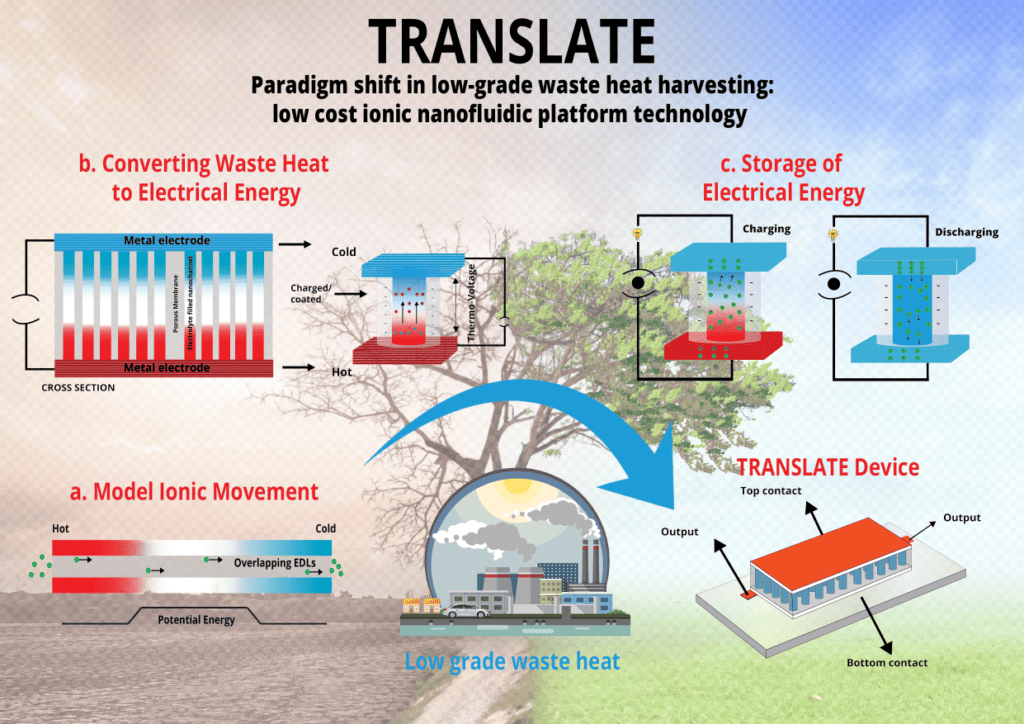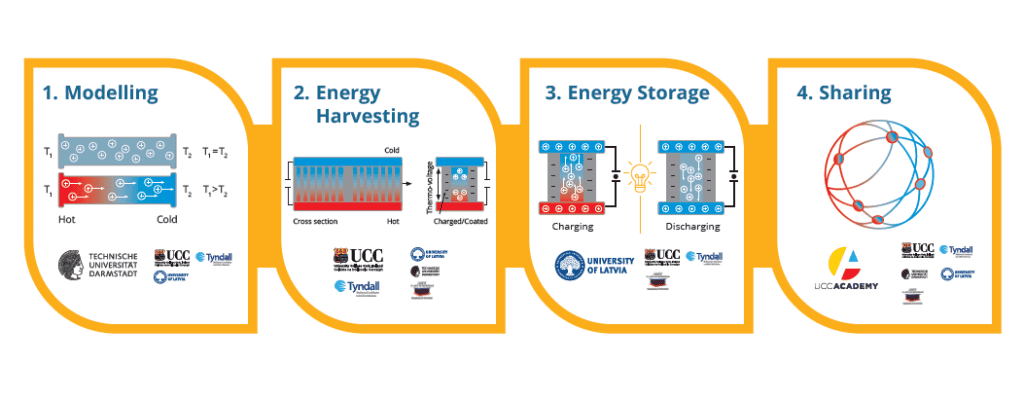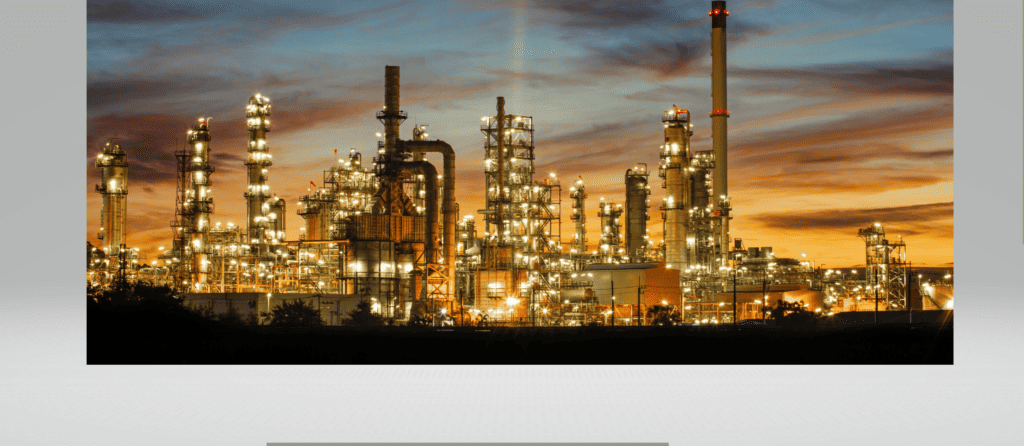Imagine a world where waste heat, the energy that’s often lost and goes unused, can be harnessed and transformed into valuable electrical energy.
This vision is becoming a reality through the groundbreaking work of the TRANSLATE project. The project focuses on developing a novel platform that efficiently converts waste heat into usable electricity, all thanks to the selective movement of ions within nanoscale channels driven by temperature gradients.

At the heart of this transformative technology lies the concept of electric double layers (EDLs) forming within narrow channels. These overlapping EDLs initiate a selective surge of ions into these channels when exposed to temperature differences. This surge generates a higher thermovoltage, a core principle that underpins waste heat conversion.
The waste heat energy harvesting part of the TRANSLATE project is built on three key phases:
Phase 1: Building a Simulation Model for Single and Multiple Nanochannels
Firstly, researchers are creating a simulation model to optimise the design of electrolyte-filled nanochannels. This design is crucial for efficient thermal-to-electrical energy conversion. Through meticulous parameter exploration, researchers can identify the most promising variables for enhancing energy conversion efficiency. This step involves comprehensive simulations, backed by comparison with experimental data. The objective is to achieve an optimised multiparameter design/model at the single and multiple nanochannel level. This is being led by Prof. Steffen Hardt from Technische Universität Darmstadt (TUD).
Phase 2: Simulation Model Comparisons with Nanochannel Fabrication in Test Cell Designs – Optimisation of Multiparameter Cell
With the knowledge gained from simulations, the next phase focuses on creating engineered cells with specifically targeted nanochannels with comparison against simulation. These nanochannels, formed within cost-effective but thermally resistive materials, serve as the foundation for generating high thermovoltages. Techniques like block co-polymer lithography and evaporation-induced self-assembly may potentially contribute to crafting precisely tailored channels. An optimised balance between thermal, electrical, geometrical and ionic electrochemical multiparamter properties is essential to achieve a maximum thermovoltage generation. Prof Steffen Hardt, along with Dr Satarupa Dutta and Dr Rajkumar Sarma of TUD are playing important roles in this phase.

Phase 3: Fabrication and Evaluation of Nanofluidic Energy Harvesting Multi-Cell Systems
The final phase of the energy harvesting objective merges the previous insights in Phases 1 & 2 into a holistic approach. System engineering is applied to create multi-cell systems targeting specific operational parameters for thermoelectric energy conversion. In the pursuit of efficient waste heat conversion, the TRANSLATE project takes a comprehensive approach by considering multi-parameter combinations. Senior Staff Scientist at University College Cork and TRANSLATE researcher Dr Ailbe Ó Manacháin’s suggestion to create a combined 3D parametric overview for simulation and experimental comparison within a single graphical analysis from the phase 1 and phase 2 activities is a noteworthy step towards understanding optimal scenarios for this innovative technology. The idea is to identify an optimised combination of parameters that would maximize waste heat conversion efficiency.
TRANSLATE’s postdoctoral researcher Dr Ievgen Nedrygailov contributes to the suggestion by emphasising the importance of incorporating experimental error bars within such an integrated assessment. This comment was appreciated by Dr Ó Manacháin as such error assessment is certainly an intrinsic part of optimising any multi-parameter space. This approach considers the inherent uncertainties in experimental results and parameter variations. By doing so, the graph becomes a representation of combined trends.
The real advantage of this combined graph lies in its ability to reveal overarching trends and correlations across a many-parameter space. This insight can guide researchers towards understanding the interactions and dependencies between different factors, helping to formulate a more informed approach to waste heat conversion and providing important input into phase 3 of the plan.
Ultimately, the TRANSLATE project’s dedication to exploring multi-parameter combinations and considering various perspectives is a testament to its commitment to revolutionising waste heat recovery and energy conversion. The project’s innovative spirit continues to push boundaries and pave the way for a sustainable energy future.
In this collective endeavour, the TRANSLATE project seamlessly blends simulation, fabrication, and integrated optimisation, forging a path towards renewable energy harvesting efficiency and innovation development. The multifaceted nature of the project fuels the development of efficient waste heat conversion methodologies, contributing significantly to a greener, more sustainable energy landscape.

By pioneering waste heat recovery and utilisation, the TRANSLATE project emerges as a beacon of hope in the quest for cleaner energy sources. Through the collaborative efforts of dedicated researchers, the project not only unlocks the potential of waste heat but also propels us towards a more sustainable world, where this once-untapped resource becomes a cornerstone of clean energy transformation.
Read more: Nanochannel Theory Explained, Potential Applications of the TRANSLATE device
Related paper: A fully automated measurement system for the characterization of micro thermoelectric devices near room temperature

